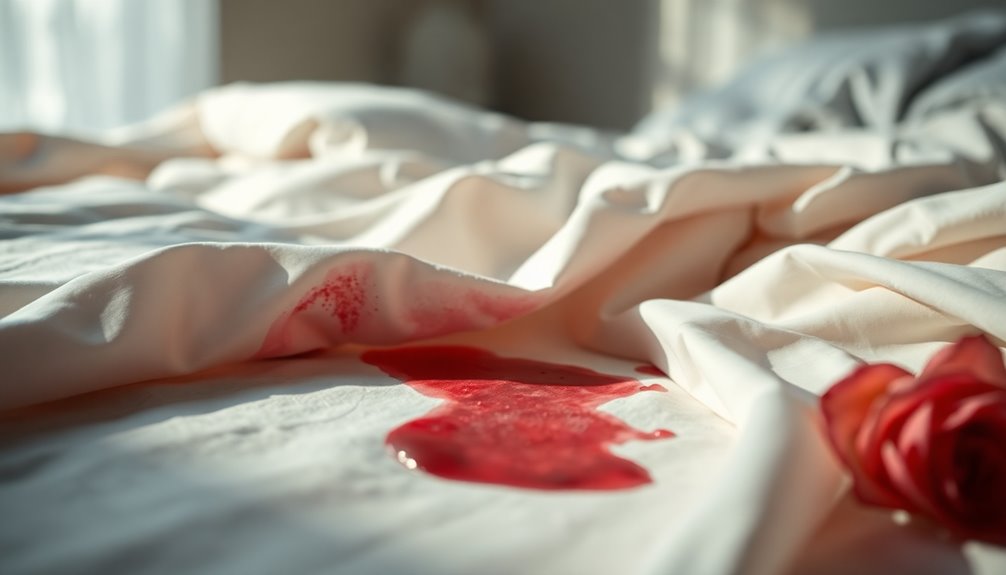Have you noticed blackheads on your inner thighs? It can make you feel self-conscious. Especially in summer, when it’s time for shorts and swimsuits. But, remember, many people deal with blackheads, even in surprising places. This guide is for those who’ve had a tough time with blackheads. It offers effective tips for treating them, especially on sensitive areas like the inner thighs.
We’ll show you why blackheads form, and how to prevent and treat them. With the right care, you can boost your confidence and enjoy smoother skin.
Key Takeaways
- Blackheads on inner thighs are common and can be managed effectively.
- Understanding sweat, oil, and friction can help in prevention.
- Regular cleansing and exfoliation are crucial.
- Choosing the right clothing can minimize the occurrence of blackheads.
- It’s important to consult a dermatologist if self-treatment isn’t effective.
- Incorporating ingredients like salicylic acid can promote healthier skin.
Understanding Blackheads: What Are They?
Blackheads are a common skin issue that lots of people deal with. Knowing more about them can help you take better care of your skin. Let’s look at what blackheads are and how they form.
Definition of Blackheads
A blackhead is a specific kind of acne, known as a comedo. It happens when hair follicles get clogged with dead skin cells and too much oil. Since the clog is open to the air, it turns black when it oxidizes. Blackheads can show up on your face and other places, like your thighs and underarms.
How Blackheads Form
The process starts with the comedo, where dead skin and oil pile up. Not taking good care of your skin can make it worse. By keeping clean and exfoliating regularly, you can fight blackheads. Making these steps part of your routine helps keep your skin clear and healthy.
https://www.youtube.com/watch?v=ys_R4KZYj24
Why Do Blackheads on Inner Thighs Occur?
Blackheads on the inner thighs happen for several reasons. Knowing these causes helps tackle the problem better.
Role of Sweat and Oil
Too much sweat and oil are key in forming blackheads. The thighs trap moisture, making them perfect for oil buildup. When sweat and oil mix, they block pores. This is common in warm weather or when you’re active. These factors make blackheads more likely.
Impact of Dead Skin and Dirt
Dead skin and dirt also lead to blackheads. They block pores when piled up. This issue is big on the inner thighs since they don’t shed skin well. Cleaning regularly reduces clogged pores and blackheads.
Friction and Chafing from Clothing
Clothing can cause blackheads too, especially tight or synthetic materials. These fabrics keep heat and moisture close to the skin. This traps pores. Also, clothes rubbing against the skin can increase oil and irritation. This raises the chances of getting blackheads.
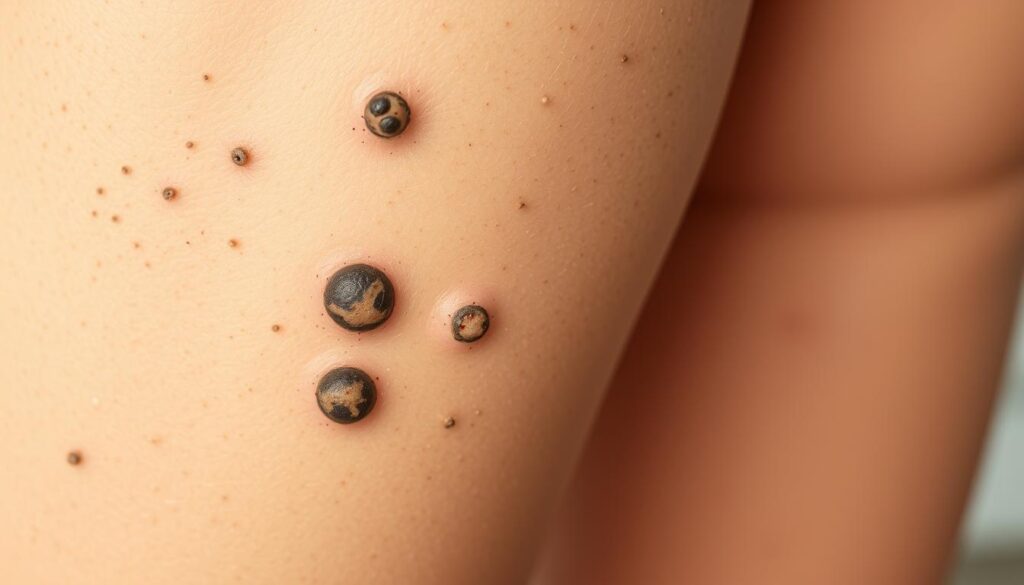
Common Causes of Blackheads on Inner Thighs
Many factors cause blackheads on the inner thighs. These include genetics, the environment, and the type of skin you have. Understanding these can help you manage and prevent blackheads.
Genetics and Hormonal Factors
Your family history affects your skin. It influences oil production and pore size. If acne is common in your family, you might get more blackheads. Hormones also play a role, especially during puberty or menstrual cycles. They can cause more oil production, leading to clogged pores and blackheads.
Environmental Influences
The environment affects your skin’s health. High humidity can make you sweat more. This can lead to more oil and blackheads. Sports and activities that cause friction can also increase blackheads. Many people notice more blackheads when they are active.
Skin Type Considerations
Your skin type is important for blackheads. Oily skin is more prone to them. This is because it traps debris that clogs pores. But, people with dry or combination skin can get blackheads too. The reasons vary. Knowing your skin type helps choose the right skincare to reduce blackheads.

How to Treat Blackheads on Inner Thighs
To treat blackheads on your inner thighs, start with a plan. This plan should include cleaning, scrubbing off dead skin, and applying special creams. With the correct methods, you can keep blackheads under control.
Cleansing Your Skin Properly
Firstly, begin with cleaning your skin well. Choose a soft cleanser that does not irritate your skin. It should remove oil and dirt easily. Cleansing daily will help prevent pores from getting blocked and lower the chance of blackheads.
Exfoliating Techniques for Effective Removal
Make exfoliation a part of your routine once or twice a week. Use products with alpha-hydroxy acids (AHA) or beta-hydroxy acids (BHA). They help get rid of dead skin that can block pores. This step is crucial to stop new blackheads from forming.
Topical Treatments: Salicylic Acid and Retinoids
Next, think about using creams with salicylic acid or retinoids. Salicylic acid helps by getting deep into pores to clear out blockages. Retinoids increase the rate of new skin cells, preventing blockages. If you don’t see improvements with store-bought products, consider seeking professional help.

| Treatment Method | Description | Frequency |
|---|---|---|
| Cleansing | Gentle, water-soluble cleanser to remove dirt and oil | Daily |
| Exfoliation | AHA/BHA treatments to remove dead skin cells | 1-2 times per week |
| Topical Treatments | Salicylic acid and retinoids to unclog pores | As needed |
Best Exfoliation Methods for Inner Thighs
Exfoliation plays a crucial role in your skincare, particularly for inner thigh blackheads. It keeps skin smooth and helps prevent breakouts. You can choose between chemical or mechanical exfoliants.
Chemical Exfoliants vs. Mechanical Exfoliants
Chemical exfoliants like salicylic acid work by dissolving dead skin in pores. They are great for oily skin due to their deep penetration. Mechanical exfoliants, like sponges, physically scrub away dead skin. Knowing your skin type helps in choosing the right method.
Homemade Exfoliation Remedies
Making your own exfoliation scrub is fun and useful. You can use simple ingredients such as sugar and honey. These DIY remedies gently remove dead skin, keeping your face clear of blackheads.

Preventing Blackheads on Inner Thighs
Proactive steps are crucial for keeping the skin on your inner thighs healthy. Simple changes in hygiene and clothing can make a big difference. This is how to maintain skin that feels and looks good.
Importance of Proper Hygiene
Keeping your skin clean is key. Choose a gentle cleanser that doesn’t clog pores. It should get rid of sweat, oil, and dirt. Wash your skin in the morning and at night, especially after sweating, for real results.
Choosing the Right Clothing
The clothes you wear affect your skin. Choose clothes that are loose and made of breathable fabrics, like cotton. This helps stop moisture and friction. Avoid tight clothes made of synthetic fabrics that can trap sweat and clog pores.
The Role of Diet and Hydration
Eating right helps your skin stay healthy. Drink plenty of water to keep your skin working well and less oily. Eating lots of fruits, vegetables, and whole grains keeps your skin healthy and aids in preventing blackheads.
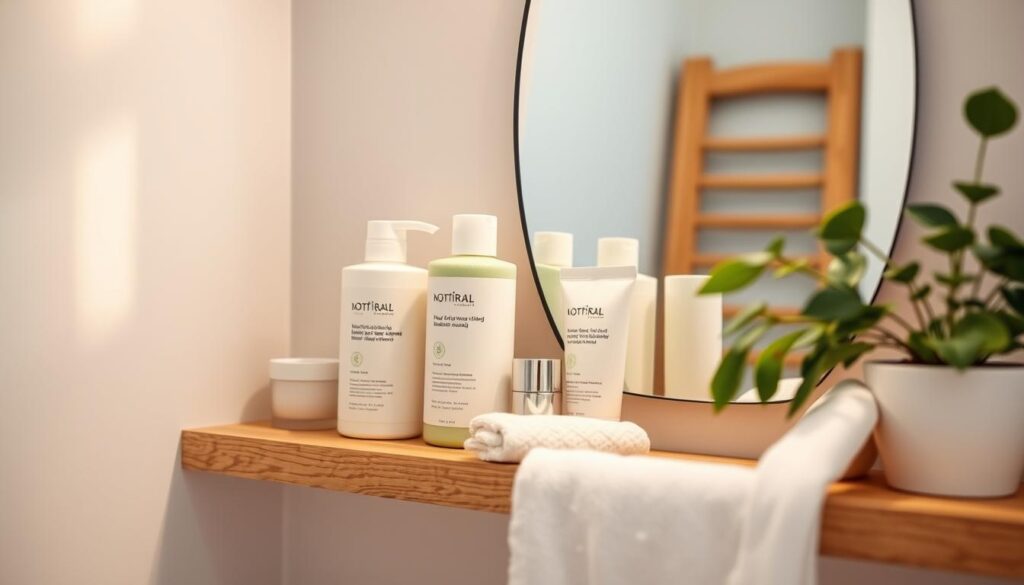
When to Consult a Dermatologist
It’s important to know when to see a dermatologist for your skin’s health. This is vital if you’re facing ongoing issues with blackheads. If concerning symptoms are present, tackling them quickly is best.
Identifying Symptoms of Hidradenitis Suppurativa
Hidradenitis suppurativa (HS) usually occurs in areas where skin rubs together, like inner thighs. It can cause painful lumps or acne-like breakouts. Look out for blackhead-like spots in pairs, warning of HS’s progress. Other symptoms to notice include:
- Abscesses that burst open, releasing a smelly mix of blood and pus
- Constant skin irritation that leads to scars
- Sinus tracts forming under the skin
- Anxiety and depression resulting from the condition
Professional Treatment Options Available
Treating conditions such as hidradenitis suppurativa professionally is key. Dermatologists offer personalized plans, which may cover:
- Medications for inflammation and infection control
- Minor surgeries to drain or remove abscesses
- Ways to prevent symptom return
Your dermatologist will evaluate your HS symptoms. They’ll then suggest the best ways to improve your skin health. This lets you work on feeling great.

My Personal Approach to Managing Blackheads
To manage blackheads well, you need a skincare routine that matches your skin and life. It’s vital to clean, exfoliate, and use special products regularly. Doing your routine without fail can make your skin better over time.
Daily Skincare Routine
A daily skincare routine has important steps to follow. Start by cleaning your skin softly to get rid of dirt and oil. Then, exfoliate often to keep pores open. Below is a simple guide for a good skincare plan:
- Morning:
- Cleanse with a product suitable for oily skin.
- Apply a non-comedogenic moisturizer.
- Use sunscreen to protect your skin.
- Evening:
- Cleanse the skin properly to remove makeup and impurities.
- Exfoliate 2-3 times a week using a chemical exfoliant, such as salicylic acid.
- Apply targeted blackhead products before bedtime.
Product Recommendations
Picking the best blackhead products can boost your skincare work. Look at these great choices:
| Product | Key Ingredient | Benefits |
|---|---|---|
| Neutrogena’s Oil-Free Acne Wash | Salicylic Acid | Gently cleanses and unclogs pores. |
| Paula’s Choice Skin Perfecting 2% BHA Liquid Exfoliant | Salicylic Acid | Effective for minimizing blackheads and oily areas. |
| Differin Gel | Adapalene | Treats existing blackheads while preventing new breakouts. |
| Murad Acne Control Clarifying Cleanser | Benzoyl Peroxide & Salicylic Acid | High effectiveness in treating acne and blackheads. |
Using these products in your daily skincare can really help against blackheads. Using them often works best. It can change your skincare routine for the better.
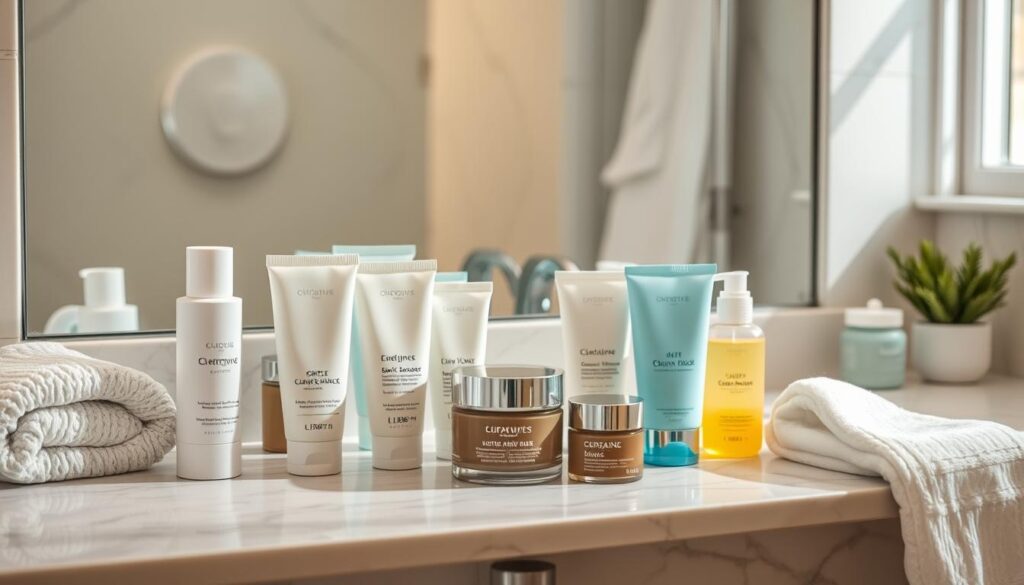
Our Favorite Natural Remedies
Looking into natural treatments for blackheads can improve your skincare habits. Using essential oils and homemade mixtures offers a soft yet strong method. With creativity and easy-to-find ingredients, you can make your DIY skincare goodies to fight off blackheads.
Use of Essential Oils
Essential oils like tea tree oil are famous for killing bacteria. Studies show that tea tree oil gel can help control acne, which means it’s good against blackheads too. To use essential oils, mix a few drops with a carrier oil and apply where needed.
Homemade Scrubs and Masks
Making your scrubs can gently remove dead skin while feeding your face. Here are some easy DIY options:
- Coffee Ground Scrub: Combine coffee grounds with coconut oil for a scrub that opens pores nicely.
- Honey Mask: Put raw honey on your face for its germ-fighting power and rinse after 10 minutes.
- Sugar Scrub: Mix sugar with olive oil for a soft scrub that doesn’t harm the skin.
Adding these natural solutions to your daily care can avoid pore blockage and enrich your skin.
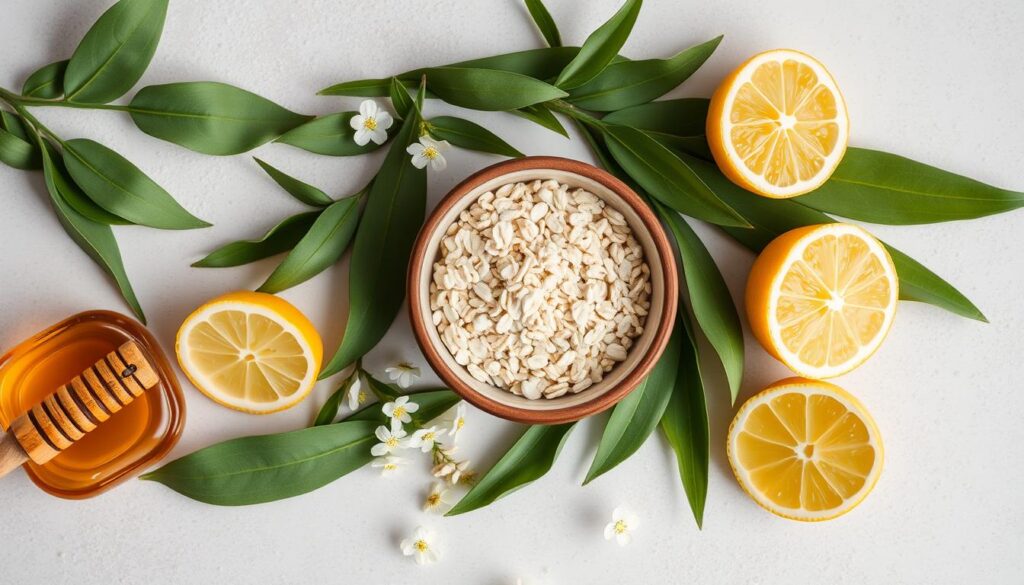
Maintaining Consistent Results
Getting clear skin is the first step. But keeping it clear takes continuous effort and the right tactics. You must craft a skincare routine that addresses what your skin needs. This routine is key to avoid blackheads and achieve lasting effects.
Long-term Care Strategies
To improve your skincare results, add these steps:
- Regular cleansing: Cleanse your skin daily to lessen oil and keep pores open. Gentle cleansers, especially those with salicylic acid, work well.
- Consistent exfoliation: Exfoliate 2-3 times weekly to get rid of dead skin cells. Choose chemical exfoliants that fit your skin type.
- Moisturization: Use moisturizers that don’t clog pores to keep your skin hydrated without causing acne.
- Sun protection: Protect your skin from the sun every day to avoid damage that can affect your skin’s health.
Monitoring Skin Changes
Watching your skin’s response to your care routine is vital. Keep an eye on these:
- Assessing outbreaks: Use a journal to track when blackheads or acne pop up to spot what causes them.
- Product reactions: Write down any bad reactions to new products so you can adjust your skincare as needed.
- Skin texture: Notice any changes in your skin’s texture or oil level. Change your products or routine to keep your skin healthy.
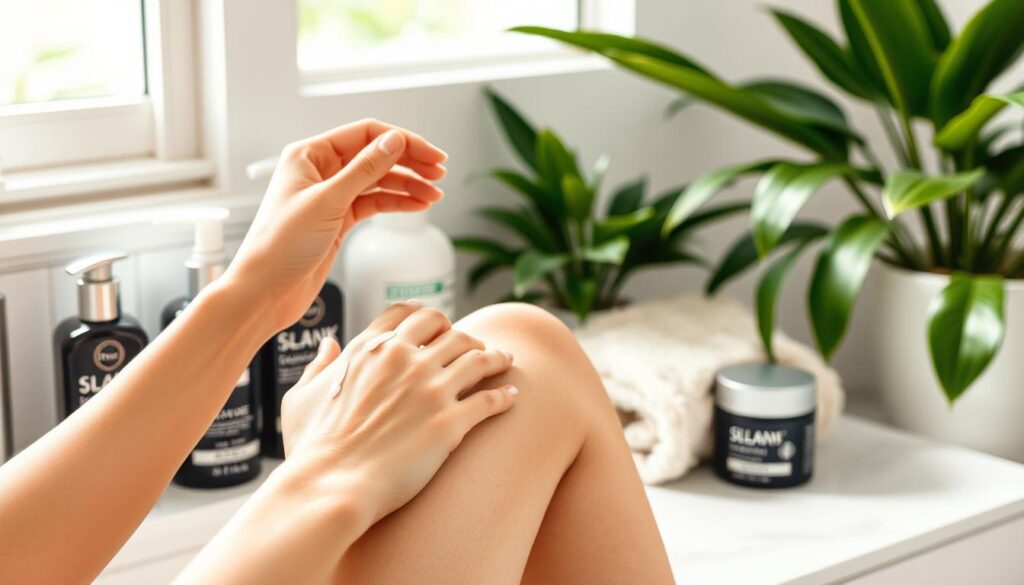
Conclusion
Getting rid of blackheads on your inner thighs is something you can manage. Knowing what causes these blackheads is the first step. They happen when oil, dead skin, and bacteria block the hair follicles.
To fight this problem, it helps to understand why they appear. Things like sweat, friction, and changes in hormones can trigger them. But, with the right care, you can deal with them effectively.
Keeping your skin clean and exfoliated regularly is key. Consider using products with salicylic acid for better results. Also, showering after workouts and controlling stress can cut down on blackheads. This could make your skin 50% clearer.
If you’re facing tough or ongoing problems, a dermatologist can help. They can offer advice that’s just right for you. With a good plan, clear and healthy thighs are within your reach.




